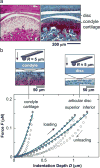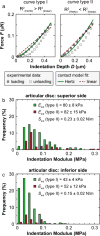Biomechanical properties of murine TMJ articular disc and condyle cartilage via AFM-nanoindentation
- PMID: 28688538
- PMCID: PMC5582691
- DOI: 10.1016/j.jbiomech.2017.06.031
Biomechanical properties of murine TMJ articular disc and condyle cartilage via AFM-nanoindentation
Abstract
This study aims to quantify the biomechanical properties of murine temporomandibular joint (TMJ) articular disc and condyle cartilage using AFM-nanoindentation. For skeletally mature, 3-month old mice, the surface of condyle cartilage was found to be significantly stiffer (306±84kPa, mean±95% CI) than those of the superior (85±23kPa) and inferior (45±12kPa) sides of the articular disc. On the disc surface, significant heterogeneity was also detected across multiple anatomical sites, with the posterior end being the stiffest and central region being the softest. Using SEM, this study also found that the surfaces of disc are composed of anteroposteriorly oriented collagen fibers, which are sporadically covered by thinner random fibrils. Such fibrous nature results in both an F-D3/2 indentation response, which is a typical Hertzian response for soft continuum tissue under a spherical tip, and a linear F-D response, which is typical for fibrous tissues, further signifying the high degree of tissue heterogeneity. In comparison, the surface of condyle cartilage is dominated by thinner, randomly oriented collagen fibrils, leading to Hertzian-dominated indentation responses. As the first biomechanical study of murine TMJ, this work will provide a basis for future investigations of TMJ tissue development and osteoarthritis in various murine TMJ models.
Keywords: Fibrocartilage; Heterogeneity; Murine models; Nanoindentation; Temporomandibular joint.
Copyright © 2017 Elsevier Ltd. All rights reserved.
Conflict of interest statement
The authors of this study have no personal or financial conflicts of interest with this work. All authors were fully involved in the study and preparation of this manuscript and the material within has not been and will not be submitted for publication elsewhere.
Figures








References
-
- Allen KD, Athanasiou KA. Viscoelastic characterization of the porcine temporomandibular joint disc under unconfined compression. J Biomech. 2006;39:312–322. - PubMed
-
- Beatty MW, Bruno MJ, Iwasaki LR, Nickel JC. Strain rate dependent orthotropic properties of pristine and impulsively loaded porcine temporomandibular joint disk. J Biomed Mater Res. 2001;57:25–34. - PubMed
-
- Bertram S, Rudisch A, Innerhofer K, Pumpel E, Grubwieser G, Emshoff R. Diagnosing TMJ internal derangement and osteoarthritis with magnetic resonance imaging. J Am Dent Assoc. 2001;132:753–761. - PubMed
MeSH terms
Substances
Grants and funding
LinkOut - more resources
Full Text Sources
Other Literature Sources
Research Materials
Miscellaneous

